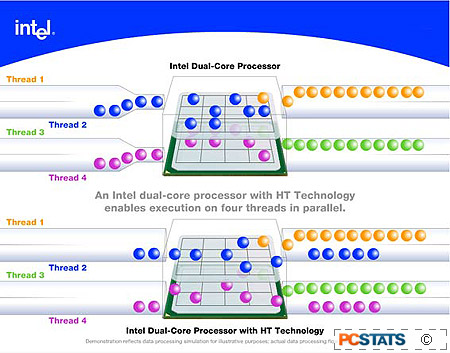Like AMD, Intel is going to split its dual-core desktop offerings into two
lines, though there will be more of a brand distinction between the two than we
see in AMD's lineup. First up (and most expensive) will be the Pentium
840EE Extreme Edition Dual core processor (note that Intel have dropped the '4'
from the title), clocked at 3.2GHz and featuring 1MB of L2 cache for each
core. It will also feature hyperthreading support, allowing it to execute
up to four threads at once. It is currently available from some retailers,
tilting the scales at a laughable $1100 USD

Following that will be the launch of the 'Pentium D' line of processors, still with 1MB of l2 cache per core, running
from 2.8GHz to 3.2GHz in speed, but without hyperthreading. Intel's prices for these chips look to
be much more aggressive than the somewhat ridiculous cost of the
high-end dual cores from both Intel and AMD. The chips will start
in the mid-$200s shading up to the mid $500s for the 3.2GHz model. All
processors listed here support Intel's EMT64 64-bit instructions.
So what we've got from Intel looks like this:
Pentium Extreme Edition 840: 3.2GHz, 1MB l2 cache
memory, Hyperthreading $1100
Pentium D: 3.2GHz, 1MB l2 cache memory,
$530
Pentium D: 3.0GHz, 1MB l2 cache memory,
$320
Pentium D: 2.8GHz, 1MB l2 cache
memory, $240
If the projected prices for the Pentium D chips hold true, AMD had better hope
that its dual-core Athlon64 X2 has a considerable performance advantage,
otherwise the company's hard-won processor advantage could be lost. Even if AMD
blows Intel away in performance, the chip giant will still own the 'low end'
dual-core market by default. This could get interesting.
Find out about this and many other reviews by joining the Weekly
PCstats.com
Newsletter today! Catch all of PCstats latest hardware
reviews right
here.
Related
Articles
Here are a few other articles that you might enjoy
as well...
1. Intel Pentium 4 3.2E GHz Prescott Processor Review
2. Intel Pentium 4 3.2GHz Extreme Edition Processor Review
